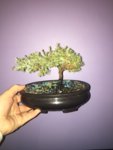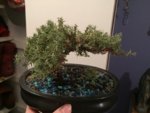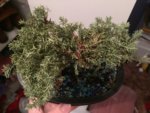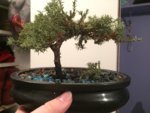You are using an out of date browser. It may not display this or other websites correctly.
You should upgrade or use an alternative browser.
You should upgrade or use an alternative browser.
Help identify!
- Thread starter lojam
- Start date
It looks like a juniper procumbens to me, but I’m not an expert. It’s really hard to tell much about the health with that photo. The foliage looks rather pale, but I can’t tell if it actually is that color or if it’s because of the lighting in the photo. If you take a few pictures of it outdoors in natural sunlight, that would help in assessing its health.I watered my plant today and noticed it was browning. I have been told this is a bonsai but I am not sure what kind. I was also wondering if it is healthy? Please help!
Shibui
Imperial Masterpiece
Definitely a juniper but that picture is so unclear it is hard to be any more specific.
Please post clear pictures to get good advice.
Also update your profile to show a location. B'nut covers most of the world and advice may be different for different climates and countries..
Please post clear pictures to get good advice.
Also update your profile to show a location. B'nut covers most of the world and advice may be different for different climates and countries..
eryk2kartman
Chumono
Do you keep it outdoors ?
Dav4
Drop Branch Murphy
- Messages
- 13,965
- Reaction score
- 35,008
- USDA Zone
- 6a
Likely procumbens juniper, likely dead/dying based on the history and color of the foliage.
That was my concern as well, but the funky lighting in that photo makes me wonder if that’s how the foliage actually looks or if it is reflected light from a camera flash too close to the subject that is making it look so pale. Aside from taking better pictures, a scratch test (scratch the trunk a little bit with a fingernail and see if there is any green underneath the bark) would answer the question more definitively.Likely procumbens juniper, likely dead/dying based on the history and color of the foliage.
Vance Wood
Lord Mugo
If you get not response from the obligatory tell me more questions it is probable we have heard the last. My opinion; the tree is dead and you should not get it near an open flame. Once a procumbens Juniper (which is what this is) starts looking dead it will not dissapoint by returning to life.
Here are my efforts at better pictures with more light sources and no flash. I agree natural light would be best but I am only able to take these after the sun sets. The trunk is a dark brown and the rest are light brown. I am located in southeast Kansas, United States. I have not kept it outdoors.
Attachments
Ali Raza
Shohin
Looks like it is deprived of outdoor sunlight and good drainage.
It appears to be still alive in the new pictures, but I’d do a scratch test if it was mine just to make sure I’m not wasting my time caring for a dead tree. It should be outside though and watered carefully. You never want to let the soil get completely dry, but it also should not be perpetually wet.
Stick your finger into the soil a little bit to check the moisture level. Water it when it’s only a little bit moist. Don’t water when the soil is still fairly wet from the last watering. When you do water it, water all of the soil surface thoroughly until water comes out the bottom of the pot.
I wouldn’t do anything else to it until it’s back to being healthy. Once it starts to put out some new growth, I’d start fertilizing it.
Stick your finger into the soil a little bit to check the moisture level. Water it when it’s only a little bit moist. Don’t water when the soil is still fairly wet from the last watering. When you do water it, water all of the soil surface thoroughly until water comes out the bottom of the pot.
I wouldn’t do anything else to it until it’s back to being healthy. Once it starts to put out some new growth, I’d start fertilizing it.
Shibui
Imperial Masterpiece
Lorax is definitely an optimist. I generally suggest that people keep seeming dead trees for a season because some species can resurrect but this is a juniper. I've never seen one come back after getting to this stage. generally they are dead well before they get to this stage. junipers usually show the signs well after they are deceased.
Keep it in hope if you like but I think this is definitely an ex bonsai. At least you can use the pot again for your next tree.
Keep it in hope if you like but I think this is definitely an ex bonsai. At least you can use the pot again for your next tree.
rockm
Spuds Moyogi
\The tree is dead. Pale, brittle, Dropping foliage in chunks like that is a very bad sign. Junipers are outdoor trees. They do not survive long inside.
Forsoothe!
Imperial Masterpiece
The great thing about Junipers is they can be dead for 2 months before the sucker who bought it knows. They should have use-it-by date so the buyer knows when to toss it. Never a houseplant.
You didn’t read my post all that carefully. I said do a scratch test to see if it’s dead.Lorax is definitely an optimist. I generally suggest that people keep seeming dead trees for a season because some species can resurrect but this is a juniper. I've never seen one come back after getting to this stage. generally they are dead well before they get to this stage. junipers usually show the signs well after they are deceased.
Keep it in hope if you like but I think this is definitely an ex bonsai. At least you can use the pot again for your next tree.
The foliage is a different shade of green in the new photos, which is what made me think it’s still alive, but it’s still hard to tell from a photo because bad color calibration of the camera is always a possibility. A scratch test, on the other hand, leaves little room for error. Green=still alive, no green=dead.
Vance Wood
Lord Mugo
Scratch testing on a Procumbens Juniper reveals absolutely nothing other than crud under the finger nails. How often do you water and where do you keep the tree? Provided the tree is alive fertilizing would be the last thing I would do with it in the condition it seems to be. It must start putting on volumes of new growth.It appears to be still alive in the new pictures, but I’d do a scratch test if it was mine just to make sure I’m not wasting my time caring for a dead tree. It should be outside though and watered carefully. You never want to let the soil get completely dry, but it also should not be perpetually wet.
Stick your finger into the soil a little bit to check the moisture level. Water it when it’s only a little bit moist. Don’t water when the soil is still fairly wet from the last watering. When you do water it, water all of the soil surface thoroughly until water comes out the bottom of the pot.
I wouldn’t do anything else to it until it’s back to being healthy. Once it starts to put out some new growth, I’d start fertilizing it.
rockm
Spuds Moyogi
At this point, that doesn't make much difference. The tree is in bad soil and has severely compromised roots--which is why the all of the foliage is olive green and brittle--the dropping brittle foliage is a more important sign than the color of the needles. It's a sure sign the tree is a goner). Scratch test may leave little room for error that the tree has living tissue, but it doesn't mean its gonna live. A juniper in this condition, even if it has green tissue under the bark, has very very very little chance of recovery.You didn’t read my post all that carefully. I said do a scratch test to see if it’s dead.
The foliage is a different shade of green in the new photos, which is what made me think it’s still alive, but it’s still hard to tell from a photo because bad color calibration of the camera is always a possibility. A scratch test, on the other hand, leaves little room for error. Green=still alive, no green=dead.
Vance Wood
Lord Mugo
Here is the sure test: The tree is small so it should not be a problem to wrap a hand around the foliage and gently squeeze. Do you hear is crunching noise? Do you find a bunch of crumbled foliage in your hand or on the floor? An alive Procumbens is very flexible and does not crunch and drop foliage. I have seen them look as green as yours and do this. They can look like this for years if rot does not set in but they are still dead. I hope I am wrong but I see no evidence of life in this tree.
Vance Wood
Lord Mugo
Rock: We seem to be posting the same thing at the same time.At this point, that doesn't make much difference. The tree is in bad soil and has severely compromised roots--which is why the all of the foliage is olive green and brittle--the dropping brittle foliage is a more important sign than the color of the needles. It's a sure sign the tree is a goner). Scratch test may leave little room for error that the tree has living tissue, but it doesn't mean its gonna live. A juniper in this condition, even if it has green tissue under the bark, has very very very little chance of recovery.
Similar threads
- Replies
- 13
- Views
- 630
- Replies
- 25
- Views
- 1K
- Replies
- 2
- Views
- 460




